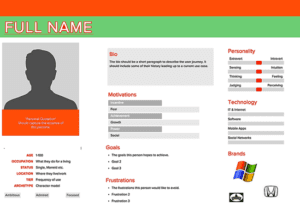Persona development is a process of developing composite and realistic representations of key segments of your audience, which helps you deliver relevant and useful content to them. It is mostly based on user research and web analytics. Here we will understand the benefits of personas, and steps to creating effective personas.
Top 5 benefits of personas
Creates a targeted sales approach:
An effective buyer persona assists your sales team by giving them a set model, which they can use in interactions with their customers. It helps them have a better idea of what kind of customer personalities they are dealing with and other related traits.
Provides fluidity for your company strategy:
You can alter your buyer personas adapting to new changes. This type of fluidity allows you to understand how your targets might have changed over time.
Promotes organizational unity:
Well documented personas will help to have clear ideas throughout your organization, serving as a single version of truth for everybody. It helps – customer service representatives, administrators, marketing and sales team, and all members who interact directly or indirectly with the customers – in increasing customer satisfaction and retention rates.
Improves lead generation:
An effective buyer-centric approach will assist in improving lead generation efficiency by generating quality information about target clients. The companies who have revised their buyer personas within last six months are found to be seven times more likely to exceed leads and revenue goals.
Upgrades product positioning and development:
Maintaining buyer personas and updating it periodically helps in upgrading existing products to a position higher. It helps in targeting new features that the buyer is looking for in your product.
Steps to creating personas
Now let us look into the steps to develop an effective buyer persona. Here, the aim is to create a focused description of your user(s) and what he/she wishes to accomplish.
Step1: Finding the users
Questions to be asked:
- Who are the target users?
- How many users are there?
- What do they do with the system?
Strategies used:
- Quantitative data collection
Outcome:
- Detailed user report
Step 2: Building a hypothesis based on buyer persona
Question to be asked:
- What are the differences among the users?
Strategies used:
- Analyzing the materials
- Grouping the users based on interest and other factors
Outcome:
- A detailed draft description of the target groups.
Step 3: Verifications and finding user pattern
Questions to be asked:
- Data based on persona, like interest, likes/dislikes, values, etc.
- Data based on a situation, like area of work and conditions of work.
- Data based on scenarios, like work strategies and goals.
Strategies used:
- Quantitative data collection with categorization.
Outcomes
- Detailed report with categories.
Step 4: Constructing persona
Questions to be asked
- User/body (name, age, image)
- Nature (introvert/extrovert)
- Education
- Background (occupation, etc.)
- Emotions and attitude toward the technology and information
- Personal behavior and traits
Strategies Used
- Categorization
Outcomes
- Description of categories
Step 5: Defining situations
Questions to be asked:
- What are the needs of this buyer persona?
- What are the situations in which it will be effective?
Strategies used
- Analyzing situation and needs based on the target audience
Outcomes
- Situation report in which persona is effective
Step 6: Validations
Question to be asked
- Do you know someone interested in this particular product or services?
Strategies used
- People who know about the persona, read and comment on the persona description
Outcomes
- Validation Summary Report
Step 7: Creating scenarios and ongoing development
Question to be asked
- What happens when a buyer persona uses the technology in giving situation and scenario
Strategies used
- Usability tests to be carried out for a new data collection
Outcomes:
- Scenarios, use cases
- Foundation document
These steps will be helpful if a company is collecting qualitative data on its prospective customers to get a strong understanding of who its customers are and why they do what they do, and motivation factors.
Here is a persona development example:

Documenting personas is vital to keeping everybody focused on the same segment of audience, and thus is increasingly becoming an integral part of businesses’ marketing strategy. How are you developing buyer personas for better conversions?




